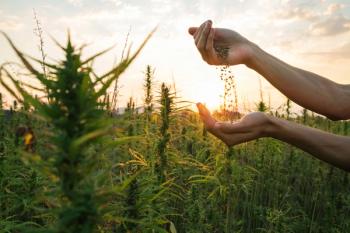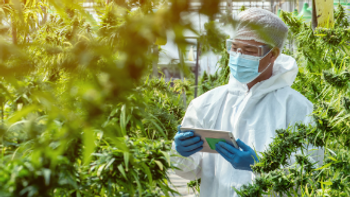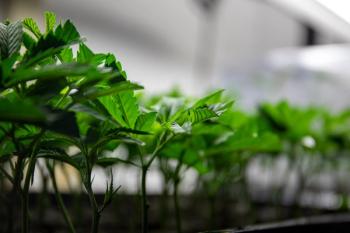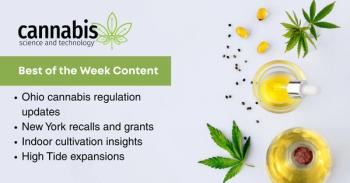
Cannabis Science and Technology
- October 2021
- Volume 4
- Issue 8
Make Data Work for You: Environmental Monitoring for Optimal Outcomes

Learn about the value of monitoring environmental conditions, how software platforms can analyze data and offer insights, and the ways growers can use data to optimize plant health and vitality.
Learn about the value of monitoring environmental conditions, how software platforms can analyze data and offer insights, and the ways growers can use data to optimize plant health and vitality.
Many environmental control systems such as lighting, heating, ventilation, and air conditioning (HVAC), and water are crucial for growers to achieve maximum yields in cannabis production facilities. A well-built integrated controls system with analytics software reduces the amount of time a cultivator spends managing environmental conditions and identifying issues in a facility. However, sensing equipment for a typical control system can generate tens of thousands of data points every single day. Translate data into useful information with analytics software. Search for patterns in environmental data to detect problems in your mission-critical systems and what conditions are resulting in the greatest crop production and quality. Learn how you can take action using fault detection and diagnostic software to fix issues and also identify recipes to achieve the best outcomes for plants.
Monitoring Grow Environments
As the old adage goes, you can’t manage what you don’t measure. But the truth is you can’t measure what you don’t monitor. If environmental conditions are out of desired parameters, plants may not show signs of stress until time passes and issues create ripple effects across the canopy.
Knowledge is power. A key way to achieve the best outcomes for your plants and ensure the optimal conditions for growth is to install sensing equipment throughout your grow rooms. Sensors track actual conditions in your facility at recurring intervals to give you a continuous log of field data you can analyze and correlate to productivity and yield. Approximately 55% of cannabis growers surveyed in 2020 report measuring light levels, 85% measure grow room temperature, and 72% measure grow room relative humidity (1).
With the variety of systems and large quantities of environmental points of data that can be collected, growers must plan how data will be used for monitoring, fault detection, and cultivation intelligence. If data is only used for emergencies, recipes for lighting, HVAC, and watering systems cannot be dialed in. Fortify facilities with the tools not just to avoid the worst outcomes, but to achieve the best.
Resource Innovation Institute (RII) is a non-profit organization committed to cultivating a better future for all of humanity. Our consortium of members brings perspectives from across the field—uniting architects and engineers, growers and operators, researchers and analysts. Together, we measure, verify, and celebrate the world’s most efficient agricultural ideas. In this article, RII’s Technical Director and members of the organization’s
Making Data with Sensing Equipment
“There’s an amazing opportunity right now because there is so much room for innovation. In systems, processes, genetics, grow mediums, automation, almost everywhere. There is no single best way to grow, and as systems change so do the processes. Whether you are trying to optimize for biomass, terpenes, or extraction, you have to start by baselining how your strains perform in your facility, start by collecting and aggregating historical batch data, then optimize cultivation recipes towards your goal,” shared Technical Advisory Council member Vince Harkiewicz, CEO of Grownetics.
It is crucial to use data from sensing equipment to achieve best outcomes for your plants. Controls Working Group members recommend placing environmental sensors to cover an average of 500 canopy square feet (300–1000 sq. ft. per sensor seen by RII Technical Advisory Council members in the field), but coverage depends on the purpose of the sensor and grow environment setup (3).
Monitoring the Canopy Environment
To optimize environmental control to suit plant growth, requirements are defined by facility design, cultivation system approaches, and the plants themselves. When the crop grows, conditions change, and the way growers manipulate cultivars can alter canopy density and the ways sensors receive data.
Sensing equipment must deliver maximum precision and environmental controls must use data from the field to inform how HVAC equipment stages on to meet plants’ needs. It’s key to understand microclimates and how they dynamically change based on the stage of plant growth and heating loads in rooms. Existing sensing equipment may monitor a limited number of data points in each room. This lack of “data density” can provide misleading information about the overall characteristics of grow rooms and likely miss key microclimate information that affects quality, consistency, and yield.
Harkiewicz noted that growing indoors with horticultural lighting systems also leads to stratification of the environment, where layers of the plant canopy undergo varying conditions. The structure of the cannabis plant can pose challenges for environmental control. When plants grow bushier, canopy can greatly disrupt air circulation, leaving warm, moist air stuck within the canopy. “This stagnant air is ripe for mold, pests, and pathogens,” said Harkiewicz.
To mitigate stratification and avoid microclimates, place sensors above and below the plant canopy. Ensure sensors are placed as close to the plant canopy as possible, not on the wall by the door. Consider intracanopy sensors to map microclimates at multiple elevations. Group sensors together to gain insights on how to choose control setpoints. For greenhouses, avoid placing climate and airflow sensors where they may be in direct sunlight or exposed to wind to avoid false readings.
Considerations for Lighting and Climate Management
Plants’ ability to convert CO2 into sugars and generate biomass and quality characteristics is directly related to the amount of light received by the canopy (4). Photosynthetically active radiation (PAR) from the sun or horticultural lighting systems drives photosynthesis and can be measured with sensing equipment. Cannabis, like all plants, requires different amounts of PAR based on their stage of growth.
Photons of light within the PAR range emitted by horticultural lighting systems are received by plants as photosynthetic photon flux density (PPFD). Photons received by the plant canopy over a photoperiod, daily light integral (DLI), is calculated by information gathered by sensing equipment. It is particularly useful for greenhouses when developing lighting recipes, balancing operation of supplemental lighting systems and sunlight. You can optimize PPFD to early stages of growth by dimming your grow lights, or by shading plants in a greenhouse. Any time you can dim lights it’s a double win because HVAC loads fall as well, this can lead to substantial energy savings.
Vapor pressure differential (VPD) directly correlates to plants’ ability to transpire. Balancing VPD along with an optimal environment for CO2 uptake is the art of environmental control for cultivation. There is not a target VPD that is appropriate for all cultivars, environments, or cultivation methods. Consider acceptable VPD ranges by stage of plant growth and then dial in HVAC system automation to tailor VPD to your specific cultivars for your system. Search for patterns in environmental data to understand if HVAC systems are maintaining room conditions within target VPD ranges.
Monitoring the Root Zone Environment
Consider monitoring a few indicator plants to gather more points such as plant water and nutrient content as well as leaf temperature. A minimum one or two moisture sensors per irrigation zone are recommended for redundant alerting, this is especially crucial in hydroponic systems because a broken valve or pump can cost hundreds of thousands of dollars in lost time and money.
Moisture sensors are often available with the addition of electrical conductivity (EC) and substrate temperature sensors. These combination sensors further help optimize root zone conditions by understanding nutrient salts build up, and optimal root zone temps for growth (5).
Hardware-Agnostic Analytics
Many growers rely on data loggers to monitor and gather targeted information, and this can be a time-intensive and manual process that has to be repeated every time teams want to analyze data. Loggers need to be placed in the environment, appropriately configured, and then manually collected. Data from loggers is typically downloaded in spreadsheet format so it can be viewed and manipulated. When growers seek more connected “real-time” sensing options, many run into issues of cost, complexity, range issues, IT security threats, and battery life issues from power-hungry sensors. Furthermore, proprietary hardware for one data point often doesn’t play well with proprietary hardware for other data points, and this compounds problems.
Reliance on control systems to provide the sensing data you need can also pose challenges. The data from control systems is often hard to access or utilize in other analytics tools when needed. This can prevent growers or consultants from easily accessing the data and acting on it accordingly. Costs and complexity that add additional points to existing controls systems can also hinder data access and retrieval. Technical Advisory Council member Tim Guiterman, CEO of InfiSense, recommends identifying monitoring systems that provide for cost-effective data density, the flexibility to let you access your data in multiple tools, and freedom to add and remove sensors based on need.
Data is the goal, and growers should expect to be able to retrieve data from multiple sensors and multiple manufacturers and have the data in one place, so it’s consistently available when they need it and is immediately actionable, avoiding wasted hours of data wrangling and cleaning. “Ensuring that the data can be accessible via API and not locked in one place provides flexibility and peace of mind and ensures data can be viewed in powerful dashboards as well as simple spreadsheets,” said Guiterman. “Growers are also increasingly relying on a growing cadre of data-driven crop analytics platforms and consultancies to provide sensors and actionable results. It is in the best interest of growers to seek out solutions that are extensible, open, and avoid vendor lock-in.”
Modern long range wireless sensors (LoRaWAN) hardware address these issues. LoRaWAN equipment used by growers that work with InfiSense can reliably communicate throughout complex facilities, indoors and outdoors, without littering the space with repeater hardware, and without relying on local IT networks. Low-power LoRaWAN sensors have long battery life that can also prevent undue maintenance and provide years of data. Sensors and loggers can provide a range of cost and accuracy options while not locking growers into one proprietary hardware vendor.
Using Data: Analyzing and Optimizing
With a unified data collection platform capturing canopy and root zone data, creating strain or cultivar specific cultivation recipes becomes a science. Understand how your cultivars grow in your cultivation systems to create your cultivation intellectual property (IP). Build IP for huge competitive advantages, especially when scaling up. Unlike other crops that have been widely studied by universities, cannabis cultivation science and controlled environment agriculture is new and innovation is rapid. Implementing new technology can be a gamble, but good data helps growers produce while continuously improving equipment and process choices.
“Making decisions without data will always be a shot in the dark, and unfortunately we see far too many grows unable to leverage the millions of data points their facilities are producing, relying solely on cultivation talent and growers’ intuition. What happens if the grower leaves? This is a barrier to quality, consistency, and scale. The best operations are data-driven and evidence based,” noted Harkiewicz.
Some tips to remember to put data to work to achieve best outcomes include:
- Capture environmental monitoring data to build strain-specific recipes tailored to cultivars, not just to react to emergencies.
- Track tasks and operations (who did what when) to understand yield outcomes and laboratory test results. Tasks and operations to track include activities such as defoliation, timing and frequency of watering events, and movement of plants in and out of rooms.
- Create a map of what conditions result in cultivars
performing best to build your operation’s
cultivation intelligence. - Train staff to implement standard operating procedures (SOPs) to consistently achieve desired yield and quality characteristics so facilities can expand with plans for performing the best.
Download RII’s new free
References
https://www.cannabisbusinesstimes.com/article/cannabis-lighting-research-2020-cultivators-growers/ .https://resourceinnovation.org/tac/ .https://catalog.resourceinnovation.org/item/best-practices-guide-automation-controls-cannabis-cultivation-435539 .https://www.cannabissciencetech.com/view/how-led-light-recipes-and-controls-can-improve-quality-and-yield-for-cannabis-producers .https://www.cannabissciencetech.com/view/rooting-for-recapture-and-reuse-impact-of-substrate-choices-on-irrigation-approach-watering-rates-and-recirculation-activities .https://catalog.resourceinnovation.org/item/best-practices guide-automation-controls-cannabis-cultivation-435539 .https://www.cannabissciencetech.com/authors/gretchen-schimelpfenig .
ABOUT THE COLUMNIST
GRETCHEN SCHIMELPFENIG, PE, As Technical & Operations Director, Gretchen manages the PowerScore resource benchmarking platform, facilitates RII’s Technical Advisory Council Working Groups, and manages RII’s continuing education program for producers, efficiency programs, and design and construction communities. She works with members and subject matter experts to publish technical guidance for the production of plants in controlled environments, develops and delivers curriculum, and supports PowerScore users with resource benchmarking analysis and reporting compliance. She authors RII’s Best Practices Guides for controlled environment agriculture. Gretchen is a licensed Civil Professional Engineer (Construction) in California and Vermont. She also has a specialty in analyzing the interactive effects between HVAC and lighting systems and commissioning controls systems. Gretchen grows vine crops, cannabis, and herbs in her veggie garden, greenhouse, and basement in her Vermont farmhouse and is constantly using her HVAC and lighting knowledge to optimize her grow environment.
ABOUT THE GUEST CO-AUTHOR
TIM GUITERMAN is the CEO of InfiSense, a software and API company that provides clean, consistent, and actionable data to the businesses that are solving today’s toughest problems—from building decarbonization to growing plants indoors with higher yields and less resources. InfiSense makes it efficient and cost effective to access hard-to-reach data with long range, long-life wireless sensors, integrate the data into any analytics tool and immediately drive results. Tim has a deep background in energy efficiency measurement and verification (M&V) and data collection and analysis, and previously was a Director of Client Solutions and Measurement at EnergySavvy and an Associate Director at Navigant. Tim earned both an MS in Building Systems Engineering and a BA in Environmental Studies at the University of Colorado, Boulder.
ABOUT THE GUEST CO-AUTHOR
VINCE HARKIEWICZ is co-founder and CEO of Grownetics. He is a longtime indoor cultivator and works with growers to design highresolution sensing and crop analytics packages as well as specialized high-efficiency automation solutions. After running an industrial design and manufacturing business in Shanghai, China he decided to combine his passions for CEA and sustainable development by founding Grownetics. Grownetics’ mission is to assist farmers in growing the best food and medicine sustainably, at scale, with no hardware lock-in. The Grownetics farm management platform is used by some of the industry’s most advanced indoor and greenhouse farms, and it pioneered several firsts, including multi-level 3D environment mapping, automatic crop analytics as a by-product of routine production tracking, and yield-driven controls recommendations.
How to Cite this Article
G. Schimelpfenig, Tim Guiterman, and Vance Harkiewicz, Cannabis Science and Technology 4(8), 34-41 (2021).
Articles in this issue
about 4 years ago
Cultivation Breakthroughs for a More Uniform Plant Are Comingabout 4 years ago
The Rise of In-line Color Remediationabout 4 years ago
Exploring the Impact of Cannabis on the Human Brain, Heart, and GutNewsletter
Unlock the latest breakthroughs in cannabis science—subscribe now to get expert insights, research, and industry updates delivered to your inbox.





